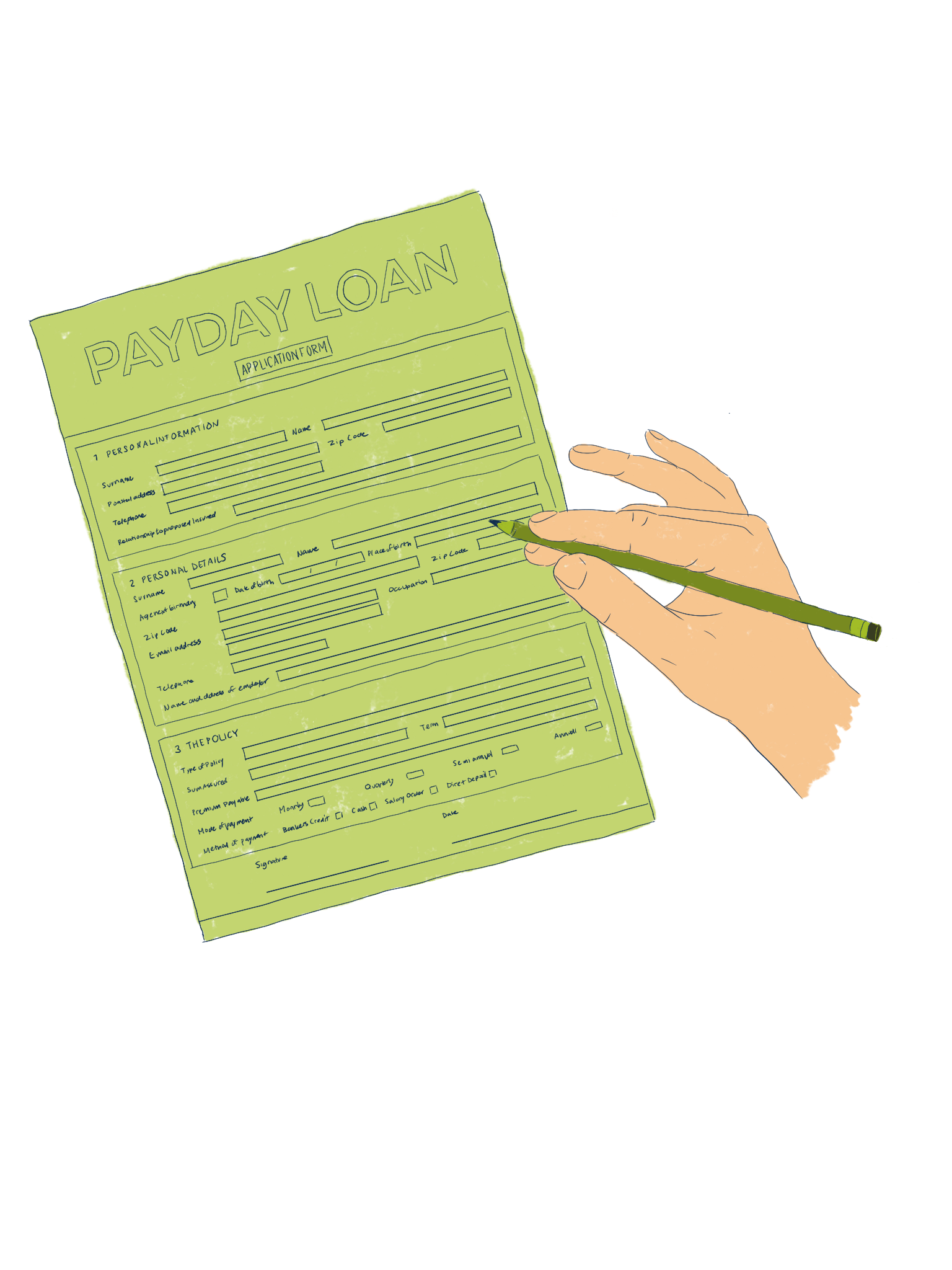There’s a cliff that so many of our families are standing on. They are staring down at the edge and one small thing could be just enough to throw them over.
Where we are
Millions of American families face financial shocks every year like an unexpected medical bill, the loss of income, a raise in rent, or loans coming out of deferment.
As a result of a tangled web of information about services, burdensome application processes, and payment systems, many families miss out on getting critical support to re-establish financial stability. More than a quarter of eligible people facing a financial shock receive no help from any Federally funded program, and Benefits Data Trust estimates that across just five programs, more than $60 billion/year in benefits are unclaimed1. And even for the families that do get access to benefits, millions waste countless hours and miss important days of work getting the help they qualify for and need. Transitioning to better jobs often requires training and gaining new skills, but this can be difficult for people to manage while still working to cover day-to-day essentials.

Of Americans who face a financial shock, 38% of Americans would face difficulty absorbing an emergency expense of $400.2
1 in 4 workers rely on safety net benefits at some point each year.3
1 Source: Benefits Data Trust
2 Source: Economic Well-Being of U.S. Households in 2021, Federal Reserve
Our approach
To start, we listened to people’s stories.
The Life Experience research team spoke with people nationwide about this moment in their lives and where the government process could have been simpler and more helpful. The listening sessions captured honest conversations about peoples' experiences, candid feedback on what could have worked better, and what really made a difference for them. Their stories have been combined and are represented here through illustrations. The quotes are real, but names have been changed.












The team conducted interviews in-person, virtually, in English, and in Spanish. Participants included people nine states and territories who represent a variety of life experiences—including those vulnerable to shocks, such as low-wage workers.
The team spoke with:
- 61 members of the public
- 12 frontline staff
- 17 state/program administrators
- 33 subject matter experts
Discovery insights
Framing for collective thinking about customer pain points
How might we improve people’s experience navigating and applying for different benefits at the same time to increase awareness, avoid confusion and redundancy, thereby improving efficiency for both program administrators and customers?
How might we encourage states and localities to use their federal funds to help people more quickly re-establish stability with available resources, and design with the most common financial shocks that may occur in mind?
How might we think about recovery and resiliency to include how we empower people through career transitions to better jobs and lasting stability?
Design Phase
Designing customer-centered solutions
View progress on our milestonesIn the 2024 design phase, the portfolio is running two pilot projects:
- Improving data services for benefits delivery is running two sub-projects. Income verification pilots will design and test concepts for income verification improvements. Medicaid renewals state technical assistance will continue supporting states to provide rapid response technical assistance.
- Supporting States to streamline access to benefits will continue working with 20 States and non-profit organizations to develop cross-program policy tools, guidance, and resources to support State benefits delivery transformation efforts.
This project aims to improve automated benefit determinations for people facing a financial shock by improving underlying Federal data infrastructure.
The work involves identifying income verification models and pilot-testing potential improvements with select states.
Project objectives
Develop and pilot improvements for benefits-related income verification determinations for benefits programs, focusing on income verification strategies that pose no or minimal burden to program applicants and participants in Medicaid, SNAP, and TANF and are affordable for states.
Updates
Income verification for means-tested public benefit programs are often complex manual processes that impose a “time tax” on the enrollees and create administrative burden for state employees. Income data is often missing, stale, or inaccurate leading to state programs requiring applicants to manually submit documentation such as paystubs to verify income. To address these challenges, the team is piloting an “income verification as a service” solution that seeks to improve income verification for means-tested programs using a consent-based verification tool. Early testing of a minimum viable product prototype has shown promising results, including reduced time for individuals to complete income verification and decreased caseworker workload. The team is continuing the pilots and evaluating the results.
See the 2024 project evaluation plan to learn about the project measures and methods.
The United States Digital Services (USDS)-led Data Services team is seeking to reduce the administrative burden of navigating Federal programs using data and technology. The team’s work in 2023 focused on improving Federal services used to verify income during application and renewals, as well as providing direct technical assistance to States managing Medicaid renewals during the unwinding of the national Public Health Emergency.
Income verification as a service. Federally funded, State-administered programs like Medicaid, SNAP, and TANF require income verification as an essential part of eligibility determinations. Electronic verification processes are currently restricted to serving traditional earners (those that receive an annual Federal W-2 tax form) and lack the means for verifying non-traditional earners (those that receive a form 1099, “gig” laborers, and populations that lack specific types of personal information like Social Security numbers). The Income Verification team partnered with CMS and SNAP to pilot technology improvements to the verification process, which aim to reduce administrative burden, expand electronic verifications for all earners, and provide more efficient and integrated service to enable cross-enrollment and minimize duplication of effort (and costs) by State administrators.
Measures of success
Key outcomes:
Successfully improving data services will decrease the time needed for benefits eligibility determinations, improve benefit verification (by increasing automatic verifications and the quality of the source data), increase sharing of data or supporting systems for eligibility determinations, and decrease the manual burden on applicants.
Design phase project measures:
This project aims to provide direct technical assistance to states to help states ensure continuous Medicaid coverage through ex parte renewal for all who are eligible during the eligibility redetermination required by the end of the national Public Health Emergency.
The work involves collaborating with states to identify and remedy system errors and weaknesses that result in procedural denials and unnecessary administrative burden for Medicaid applicants and participants, and adopt best practices in benefits delivery.
Project objectives
Work with specific states to identify and remedy IT system issues resulting in procedural denials, and improve continued Medicaid coverage rates through increasing ex parte renewals and other burden reduction strategies.
Updates
This project aimed to improve the processing of millions of Medicaid renewals at the end of the national Public Health Emergency by increasing the ex parte (automatic) renewal process. Data-driven auto-renewals help eligible individuals remain enrolled with minimal paperwork, reduce processing times, and allow caseworkers to focus on more complex cases. The team provided direct technical assistance to states to identify and remedy IT system errors and weaknesses that resulted in procedural denials and unnecessary administrative burden for beneficiaries. They also guided states in adopting best practices for benefits delivery. As a result of these interventions, over 5 million people have been re-enrolled in Medicaid, saving states more than 2 million hours of caseworker time, and the numbers keep growing as the changes to the state benefit systems have proven to be enduring. The project team is supporting the Center for Medicaid and CHIP Services in building long-term capacity to partner with states.
See the 2024 project evaluation plan to learn about the project measures and methods.
The United States Digital Services (USDS)-led Data Services team is seeking to reduce the administrative burden of navigating Federal programs using data and technology. The team’s work in 2023 focused on improving Federal services used to verify income during application and renewals, as well as providing direct technical assistance to States managing Medicaid renewals during the unwinding of the national Public Health Emergency.
Medicaid renewals rapid response. With the unwinding of the national Public Health Emergency, States restarted eligibility renewals for more than 90 million people covered by Medicaid. This renewal volume has caused significant operational challenges for States and placed a considerable burden on Medicaid recipients seeking to renew. To tackle this challenge, USDS deployed a rapid response team to provide direct technical assistance to States to understand and identify opportunities to streamline and simplify State workload and customer experience. Through this work, the Center for Medicaid & CHIP Services (CMCS), USDS, and State partners identified an error in State eligibility systems that resulted in erroneous coverage losses for over 500,000 children and families[1]. Thanks to the hard work, all 500,000+ people will have their Medicaid coverage reinstated across nearly 30 States. Beyond the resolution of this error, the rapid response team’s efforts on the ground in States have enabled millions of people to be renewed for Medicaid, as required by law, using existing data (ex parte), significantly reducing the burden on individuals and preventing administrative churn[2], in particular for children. Rapid response teams have also implemented customer experience improvements with State partners, from improving renewal websites to redesigning the envelopes that package mailed notices.
[1] https://www.medicaid.gov/sites/default/files/2023-08/state-ltr-ensuring-renewal-compliance.pdf
[2] Administrative churn occurs when an individual is disenrolled, likely due to the administrative burden of renewal processes, and then re-applies within a short period. Medicaid churning and continuity of care [ASPE, 2021]
Milestones
Measures of success
Key outcomes:
Develop tools and guidance for States to streamline policies and benefit determination operations and modernize their IT systems for public benefits management. The long-term outcome is accelerating State delivery of the multi-program 20-minute application and reach eligibility determinations in one day.
Design phase project measures:
This project aims to help states innovate and improve Federal-state benefits access and delivery towards the goal of allowing families to apply for core benefits in 20 minutes and receive eligibility determinations within a day.
The work involves clarifying Federal policy and requirements, providing guidance in crucial areas, developing resources and tools that states can use, better utilizing data for operations and performance, providing technical assistance to states, and coordinating and leveraging Federal and non-governmental efforts and investments.
Project objectives
Provide guidance and resources to help states reduce administrative burdens and improve service integration in benefits programs by replicating best practices and delivery innovation. Replication focus areas include policy, data-sharing, human-centered design, technology, operations, and procurement. To ensure responsiveness to state needs, this team will co-design products with states through individual state engagements, standing state-Federal workgroups, listening to benefits access stakeholders, and coordinating with key Federal partners and key non-Federal stakeholders.
Updates
This project aimed to help states identify and implement best practices in benefits delivery by clarifying Federal policies and requirements, providing easy access to tools and resources, and fostering peer learning opportunities. The project convened state benefits leaders and staff from 30 states monthly on topical workgroups and at two annual summits to learn from each other and from experts, as well as collect and share best practices, including in areas such as call centers, plain language, text messaging, data sharing, automation, and performance management. The team also clarified policies on state government texting for public benefits, coordinated the development of a joint HHS/USDA framework on the use of AI in public benefits delivery, published an updated guide on digital services vendor management, and provided direct technical assistance to multiple states on procurement.
See the 2024 project evaluation plan to learn about the project measures and methods.
In 2023, the Supporting States (“Accelerator”) team collaborated with the Aspen Institute Financial Resilience Program to convene six monthly workgroups focused on remediating delivery barriers States face: data-sharing, operations, policy and requirements, procurement, talent, and text messaging and notifications. Twenty States have attended regular meetings, including Federal staff, stakeholders, and independent experts. States are identifying specific challenges, sharing insights, and beginning to develop valuable resources. The Accelerator team also organized a training led by agency colleagues at the Federal Communication Commission to clarify permissible uses of text messaging to communicate with benefits program participants. The team is developing data sharing and reuse guidance to facilitate State use of Federal and third-party data for verifications. The team is exploring State solutions to address talent needs and better incorporate human-centered design and collection of feedback on lived experiences into program operations. The team is developing other supports for State operations in text messaging, plain language notices, call centers, and account access. The team also conducted research with States and experts to identify and prioritize leading procurement practices for benefits programs for potential Federal pilots to come.
Milestones
Measures of success
Key outcomes:
Develop tools and guidance for States to streamline policies and benefit determination operations and modernize their IT systems for public benefits management. The long-term outcome is accelerating State delivery of the multi-program 20-minute application and reach eligibility determinations in one day.
Design phase project measures:
Project Documentation
- Portfolio Charter
- Portfolio Summary
- Design Project Summary: Improving Data Services for Benefits Delivery
- Design Project Summary: Supporting States to Streamline Access to Benefits
- Customer Journey Map & Stories
- Information collection approved under OMB Control #3206-0276
- Life Experience Initiative Summary
- Executive Order 14058
- President’s Management Agenda
Project Outputs
- FFS CX Best Practices
- FCC Training on Public Benefits Texting
- Evaluation Plan: Improving Data Services for Benefits Delivery
- Evaluation Plan: Rapid Response State Technical Assistance
- Evaluation Plan: Supporting States to Streamline Access to Benefits
Agency collaborators
- General Services Administration (GSA)
- Department of Labor (DOL)
- Department of Housing and Urban Development (HUD)
- Department of Agriculture (USDA)
- Office of Management and Budget (OMB)
- Department of Education (ED)
- Department of Health & Human Services (HHS)
- U.S. Department of the Treasury (Treasury)
- Social Security Administration (SSA)
